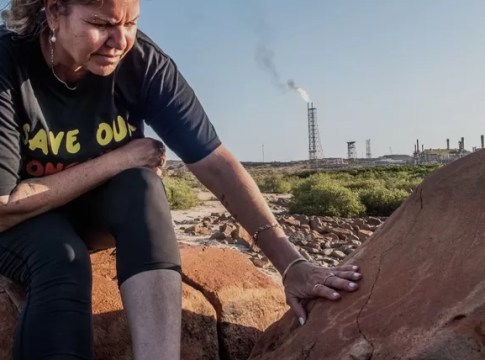Murujuga World Heritage Listing Sparks Calls to Block Gas Hub Expansion
“Today, Australia rewrote the World Heritage listing in the interests of the gas industry.”
— Raelene Cooper, Mardudhunera custodian and founder of Save Our Songlines
The Murujuga rock art on Western Australia’s Burrup Peninsula has officially been added to the UNESCO World Heritage list—an achievement celebrated by Traditional Owners and environmental groups alike, but one marred by the omission of key protections recommended by international experts.
UNESCO’s 47th World Heritage Committee confirmed the listing this week in Paris, recognising the site’s “outstanding universal value” as the largest and oldest continuous collection of rock art in the world. With over one million petroglyphs dating back 50,000 years, Murujuga documents continuous Aboriginal occupation and rich cultural knowledge.
But behind the celebration lies concern. First Nations leaders and scientists warn that industrial pollution from the neighbouring gas industry is accelerating the weathering of these irreplaceable petroglyphs—and say the Australian government lobbied to have conditions protecting the site removed from the final UNESCO decision.
Advertisement:
Raelene Cooper, who travelled to Paris with other First Nations representatives to lobby for strong protections, welcomed the World Heritage recognition but said the victory had been diluted by political interference.
“Even though all of the recommended protections were removed after concerted lobbying from the Australian government, we are still overjoyed to see Murujuga finally World Heritage listed by UNESCO,” Cooper said.
Environment Minister Murray Watt had travelled to Paris ahead of the listing, where he met with European ambassadors to push for approval of the listing without strict conditions. The lobbying succeeded.
Despite scientific studies—including a report from Bonn University and the World Heritage advisory body ICOMOS—showing industrial emissions are degrading the rock art, the final listing did not include the proposed requirement to end such emissions.
“Meanwhile, fertiliser plants are still being built around our sacred sites and polluting gas plants will emit toxic acid on our rock art for another 50 years… Global scrutiny will now be applied to what is happening at Murujuga. We will continue to fight for protection for this very special place,” Raelene Cooper said.
Advertisement:
In May, Minister Watt conditionally approved Woodside’s application to extend its North West Shelf LNG gas export facility until 2070. The Australian Conservation Foundation (ACF) is urging him to reconsider in light of the new World Heritage status.
“The onus is on the Australian government to make sure the values recognised by UNESCO are not jeopardised by ongoing industrial pollution,” said ACF CEO Kelly O’Shanassy.
“If Minister Watt is serious about protecting Murujuga’s now globally recognised values… he should reject Woodside’s proposal to extend its gas hub.”
ACF’s analysis has found that lifetime emissions from Woodside’s gas export operations would be more than 13 times Australia’s total annual emissions across all sectors. That facility is also the single largest emitter impacting the Murujuga petroglyphs, according to both independent and government research.

Archaeologist Professor Ben Smith, an international expert in rock art, criticised the government’s handling of the science behind the nomination.
“The scientific data clearly demonstrated the advanced weathering of the Murujuga petroglyphs from heightened levels of certain airborne pollutants,” he said.
“Yet we saw this repeatedly dismissed by different levels of government, with graphs and data being manipulated to back up the narrative that no conditions were required for the listing.”
Prof. Ben Smith is Professor of Archaeology (World Rock Art), University of Western Australia.
Advertisement:
Sam Walker, a Ngarluma custodian, also submitted evidence to UNESCO and ICOMOS recommending independent oversight of pollution impacts at Murujuga.
While the listing of Murujuga as a World Heritage Site marks a historic recognition of Aboriginal cultural heritage, Cooper and her fellow custodians warn that the real battle has only just begun.
“This is a momentous day for our old people and our future generations,” Cooper said. “But the fight is far from over. The world is now watching, and we will not stop until Murujuga is protected—properly and permanently.”
With the gas hub approval still pending, pressure is mounting on Minister Watt to align Australia’s environmental policies with the global recognition Murujuga has now received. The question remains: will this listing lead to genuine protection, or become another hollow accolade drowned out by the roar of industrial expansion?
Related stories
Tensions Rise Over Murujuga Rock Art and Industry Ties
Murujuga Custodian Sues Environment Minister Over WA Rock Art
Murujuga Rock Art Threatened by Woodside Gas Hub
Gas Industry’s Manipulation of Traditional Owners Questioned
Meet the Frackers: Gas explorers in Australia
Woodside’s North West Shelf (NWS) Gas Project
Advertisement:




